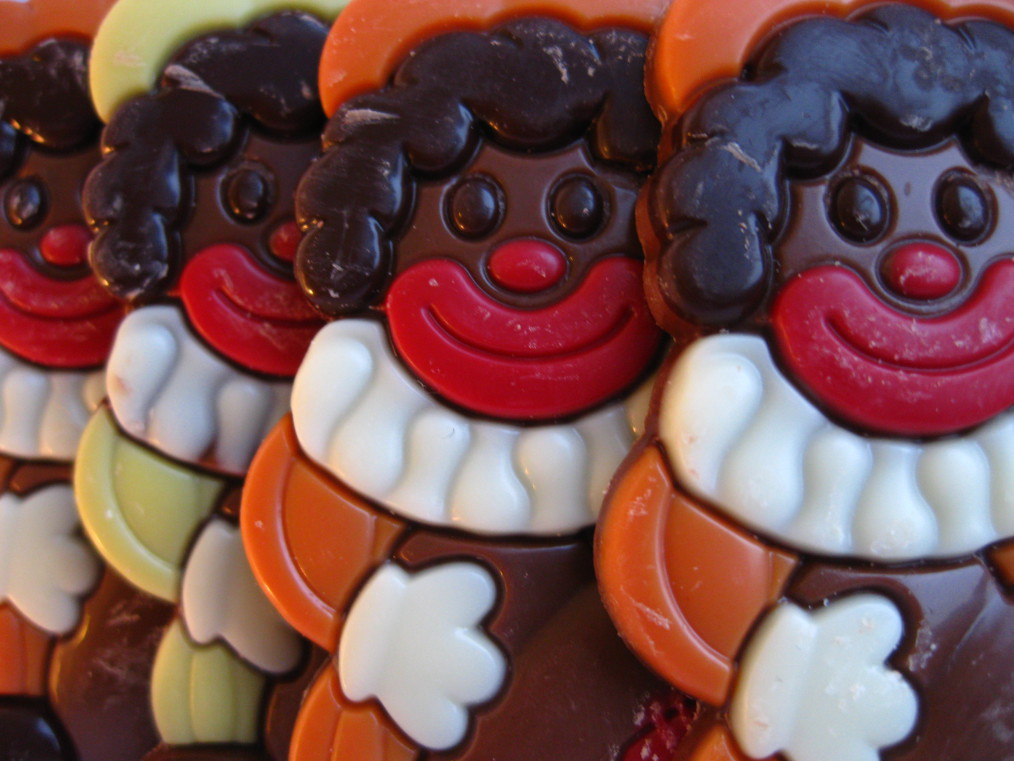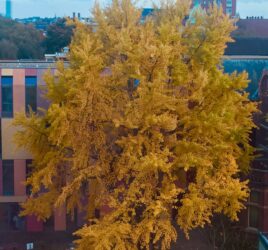
Zwarte Piet: Chocolate, Gifts & Controversy
by Jolien van Breen, in collaboration with Maja Kutlaca, Aafke van Mourik Broekman, Julia Sasse, Felicity Turner, and Janine Weeting
For the last few years, Sinterklaas has not only brought gifts and chocolate, but also controversy: Is the character of Sinterklaas’ helper – Zwarte Piet – racist or not? And should we change the celebration? This issue has led to a heated debate between proponents of Zwarte Piet, who want to keep the celebration as it is, and opponents of Zwarte Piet, who think the celebration should change. The debate has become increasingly extreme, reaching a low point in October last year, when the famous Dutch singer Anouk received death threats for arguing for a change to the Sinterklaas celebration. Currently, several PhD students from the Social Psychology department are working together to investigate people’s perceptions of the Zwarte Piet debate, and people’s willingness to change the celebration.
“Changing the Sinterklaas celebration might be seen as a threat to national identity”
From a social-psychological perspective, there are several processes that might affect people’s views on this issue. Firstly, changing the Sinterklaas celebration might be seen as a threat to national identity. The celebration of Sinterklaas is valued not only as a celebration with gifts, but as a tradition with cultural value. It is something that is “uniquely Dutch” and forms part of Dutch national identity. When people perceive that a part of their identity is threatened, they may respond in emotional and even aggressive ways (Inzlicht & Kang, 2010). These identity concerns are also reflected in perceptions of victimhood. To most outsiders, it seems that black people are the victims in this situation, as they might feel discriminated by the stereotypical representation of Zwarte Piet. But in fact, from the discourse in the media, it is evident that many proponents of Zwarte Piet actually perceive their own group as a victim group, because they are asked to give up a highly valued cultural tradition. In addition to creating a threat to national identity, the debate suggests that those who defend Zwarte Piet might be racist, which is a threat to their moral identity because it portrays them as being prejudiced. More so than traditions and customs, morality goes to the heart of identity (Leach, Ellemers, & Barreto, 2007). Any threat to moral identity, therefore, is responded to more extremely. We believe that this is part of the explanation for why the debate surrounding Zwarte Piet has become so extreme. We expect that those who identify more strongly with a Dutch identity, and emphasise cultural value of the Sinterklaas celebration, will perceive themselves as victims and be less supportive of changes to the Sinterklaas celebration.
A second relevant factor in predicting opinions, is the opinion of others. Research on polarisation has shown that extreme opinions contribute directly to attitude change (Feldman, 2011), and that attitudes of moderate group members tend to shift over time towards the opinions of the more radical members (Wojcieszak, 2011). However, in the context of the Zwarte Piet debate the opposite seems to have happened: people have begun to be uncomfortable with extreme opinions, even when they are generally in line with their own view, probably because people fear these extreme opinions might contribute to conflict escalation. In this situation, people may begin to feel shame and guilt, as the opinions of their in-group members become more and more extreme (Johns, Schmader, & Lickel, 2005). This, in turn, might lead people with moderate opinions to become more open to changing the current celebration.
“People have begun to be uncomfortable with extreme opinions, even when they are generally in line with their own view”
Moreover, the influence of others’ opinions on one’s own view may depend on the group membership of the other person: Who is the person calling for change? Last year, online communities were outraged when it seemed the UN were getting involved in the debate. We believe this is linked to the so-called “inter-group sensitivity effect”, which suggests that people are more likely to accept criticism from other members of their own group, than from members of another group (Hornsey & Irmani, 2004). In the context of this study, we hypothesised that when the celebration is criticised by a Dutch person, people would be more willing to consider change than when the celebration is criticised by a non-Dutch person.
Though some changes to the Sinterklaas celebration have recently taken place, we can expect that, now that we have said our good-byes to Sinterklaas and he has returned to Spain, the discussion will remain. Next year, Sinterklaas will again bring along a heated debate. By combining insights on social identity, inter-group relations and polarisation, our research aims to shed light on the psychological processes that influence how such controversies develop. We hope that our research will improve our understanding of the development of such debates, and how we might reach consensus on sensitive social issues.
References
Feldman, L. (2011). The opinion factor: The effects of opinionated news on information processing and attitude change. Political Communication, 28(2), 163-181.
Hornsey, M. J., & Imani, A. (2004). Criticizing groups from the inside and the outside: An identity perspective on the inter-group sensitivity effect. Personality and Social Psychology Bulletin, 30(3), 365-383.
Inzlicht, M., & Kang, S. K. (2010). Stereotype threat spillover: how coping with threats to social identity affects aggression, eating, decision making, and attention. Journal of Personality and Social Psychology, 99(3), 467.
Johns, M., Schmader, T., & Lickel, B. (2005). Ashamed to be an American? The role of identification in predicting vicarious shame for anti-Arab prejudice after 9–11. Self and Identity, 4(4), 331-348.
Leach, C. W., Ellemers, N., & Barreto, M. (2007). Group virtue: the importance of morality (vs. competence and sociability) in the positive evaluation of in-groups. Journal of Personality and Social Psychology, 93(2), 234.
Wojcieszak, M. (2011). Deliberation and attitude polarization. Journal of Communication, 61(4), 596-617.
Note: Image by Toon Kuppens




As someone foreign living in this country, I do not feel that I should get too involved in the debate of what to change about the Sinterklaas tradition. But nevertheless I am a part of this society and I feel the urge to address two things in this debate:
1. The fact that it seems to be a matter of discussion, whether or not Zwarte Piet is racist. Most Dutch article imply that this is something to discuss about, so does this article. Why?
It obviously is! White people painting their faces (pitch) black, their lips in bright, fat red and acting as “servants”? Ask any person from any other country and the only sane reaction would be to label this racist. Discuss the impact of Zwarte Piet, discuss the role in the Sinterklaas tradition, discuss if and how to change it, discuss what ever an open debate in a society needs to discuss to overcome the issue. But please, please, please… Stop denying racism.
2. The reactions in the debate are really scary and it should be stressed, that nobody wants to stop Sinterklaas from happening. The worst-case scenario would be to stop Zwarte Piet, and I guess most advocates for this side of things don’t even want to go that far. So please stop implying that this is a discussion of tradition vs. anything. It’s not! It is a discussion about a) being a society that shows blatant ignorance about a minority vs. b) being a society that changes PART of a tradition to convey a message of tolerance and openness.
Anyway, this article gives an interesting insight into why people behave how they do on a psychological level, and that is good. But even if we understand ignorant behavior and fallacies of human thought, we do not need to tolerate it.
Those who protest against Zwarte Piet should take a lesson from Dutch coolness: Wilders dyes his hair and acts all crummy to mock Dutch people. No-one complains. But when the Dutch do it all hell breaks loose.
Nice piece, and very interesting to read a social-psychological perspective on this matter!
The only way, it seems, to solve this problem, is for people to put themselves “in the other side’s shoes”. Note: These are not only the shoes of the people who feel hurt by Zwarte Piet’s image, and would like to change this tradition, but also the shoes of people who feel their moral identity is threatened when other people call their tradition racist. Both sides are equally important, because the only way to solve this problem is when they work together, to find a solution that fits everyone, so that no one feels left out because of any personal characteristic.
I know this is much easier said than done. My hope for next year? That people stop telling the other side why their view is wrong, and start discussing how we can shape Sinterklaas in a way that suits both sides in an equal way. Is such a solution even possible with these two opposing views? The only way to find out, is to stop polarizing, blaming, threatening, discriminating, and talk to each other.
Good luck with the study!
Thank you for your comments. We would like to emphasize that our article is not meant to be about whether Sinterklaas is racist or not, but about the factors that contribute to the development of the debate. Interestingly, themes raised in the above comments – including intolerance and requests to stop denying racism inherent in the portrayal of Zwarte Piet – present an interesting example of criticism which seems constructive, but might in fact compound identity threats experienced by those who support Zwarte Piet. According to research in the social identity tradition (Tajfel & Turner, 1979), for an individual who identifies strongly as Dutch and celebrates Sinterklaas, there may be no (psychological) difference between calling the tradition racist and the individual racist. Thus, asking a supporter of Zwarte Piet to acknowledge that he is a racist figure is presents a strong and direct threat to their moral identity and could potentially deflect attention away from more constructive ways to solve the debate. Indeed, moral threats to group identity can evoke defensive reactions and may lead people to direct the anger and outrage towards other groups instead of focusing on improving the image of their own group (Tauber & van Zomeren, 2013). In order to motivate people to actually change their behavior it is more fruitful to frame the critique in a non-moral way: for example instead of talking about racism one could emphasize how empathy towards others needs is important for a harmonious multicultural society.
I found it somewhat ironic how in a title article of my local newspaper the discussion about Zwarte Piet was undermined. The author basically made two arguments:
First, the Zwarte Piet tradition already exists so long, why must we have this discussion now? (One should be careful with this argument, considering that the Zwarte Piet character indeed originated in a society that was quite open racist against black people.)
Second, how should we tell our children? This might indeed be a nice point for a psychological study, maybe a collaboration of developmental and social psy. My spontaneous thought was, when children believe that Sinterklaas comes from Spain and that the Zwarte Pieten are black because they go down the chimneys (how many houses nowadays have chimneys, after all, particularly such big enough for a Zwarte Piet to climb down?), why shouldn’t they believe another story?
For example, tell them that the chimneys have been cleaned recently and thus the Zwarte Pieten do not become black any more. Now you can see their real colors, and you could tell them all kinds of stories why a Cheese Piet is yellow (because he eats too much cheese?), why a Shower Piet is blue (because he is showering all day long?), and so on.
My hypothesis is that children would believe these fairytales just as well as the present one.
Interesting perspective on this debate. I particularly liked the ‘national identity’ issue – Onne Janssen has published an interesting paper on how innovative behavior can lead to conflict, especially when personal involvement is high. Allow me to shamelessly plug a short (Dutch, sorry internationals) piece I wrote about this last year: http://www.rug.nl/research/sustainable-society/column/2013/sinterklaas-en-de-innovatie
Dear Stephan,
Thank you for your comment. Regarding the point about the children, this is also an issue brought up by our participants. We asked people to tell us who they thought was disadvantaged by the debate, and the most common answer was “children” because it is ‘their’ celebration that is being changed by the adults.
Could you let me know the name of the newspaper in which you saw this article? I would like to look it up.
This study is done from the point of view that all truths and values are arbitrary and therefore non-existent and that they therefore can be replaced by whatever other concepts and values one chooses. In my opinion this is reprehensible.
This research also appears to be conducted from a racist point of view: “a stereotypical representation of “Zwarte Piet”, which suggests that the researchers all agree that Zwarte Piet represents a negroid person – for which assumption they offer no proof whatsoever.
Furthermore, the researchers appear to be unaware that the Sinterklaas rituals qualify as a religion – or if they are aware of that fact they are keeping silent about it. So what they are actually studying is whether or not the dogma’s of a religion and the attributes of the (pagan) gods of that religion can be changed by social engineering, i.e. by fooling and deceiving the believers.